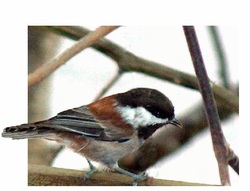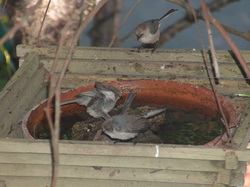
This morning I noticed one of my chestnut backed chickadee babies had an injured wing. I followed it about, observing its behavior. It was flying but not really very well, staying low, and moving up a tree, one branch at a time. I went into the house to get a handkerchief and a small box but when I returned, I could not find my little friend.
So I left my kerchief and box ready for action and came out again a few hours later. Once again the little bird was about, but as I approached, he/she moved away.
I came out again in the early evening and now the little bird was lower down, hopping about on the ground, foraging. I was able to toss my handkerchief over it at one point but it got out from under before I could actually grab it. I followed it as it went outside the fence, down the parkway, into the other back yard (of my barn). I felt it was moving away. What to do?
I went back to my house and got some suet and put it on a plate. Then I got my iPhone that has the App with the bird calls and went back to where I last saw the chickadee. I played the bird call of the chestnut backed chickadee and definitely got its attention. It seemed interested but then it was very strange, it seemed to get tangled up in some of these tiny branches that birch trees have, and all of a sudden, my little bird was upside down, all wrapped up in twigs, and would have died had I not been there. TIMING IS EVERYTHING.
So I was able to throw my handkerchief over the little bird and put him/her into my box and took it down to Native Animal Rescue http://www.nativeanimalrescue.org/. They checked the chickadee out and thought the wing was broken and it should be okay after keeping it taped for a bit. They had a number of birds there being treated. This is a wonderful organization and worthy of your support.
So the bottom line when you find an injured bird, is to have a VERY lightweight cloth, the consistency of a handkerchief is perfect. This also applies to trapped birds (we have had TWO just this week in our back porch: starling juvenile and an oak titmouse). Try to toss the kerchief over the bird. This seems to quiet them enough so that you can GENTLY scoop them up and put them in your box (or release them).
I have a variety of watercolors and batiks of bird life on my website: www.ladywholovesbirds.com. Please take a look at my offerings at my ETSY site: https://www.etsy.com/shop/LadyWhoLovesBirds.
Alexandra Sanders, BA AKA LadyWhoLoves


 RSS Feed
RSS Feed
